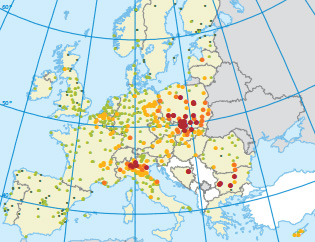EU consults on revision of air pollution strategy
Views are being sought by the Commission on the best ways to improve Europe’s air quality policy due to perceived problems with the current strategy, writes Michael Holder
The European Commission is seeking views from the public on the best way to improve air quality in Europe.
The Commission has launched a consultation which will inform a review of Europe’s air quality policies, which is due to report in September 2013.

Map showing annual mean concentrations of PM2.5 in Europe in 2010 (red dots signify the highest levels of pollution) – the Commission is now seeking views on how to improve its air quality policy.
Running from 10 December 2012 until 4 March 2013, the consultation focuses on the EU’s Thematic Strategy on Air Pollution (TSAP).
The TSAP was launched by the European Commission in 2005 with a stated aim “to achieve the levels of air quality that do not result in unacceptable impact on, and risks to, human health and the environment.”
However, the ongoing review has highlighted problems with the TSAP and will include recommendations on updates for the strategy when it reports back next year.
Part of the EU’s Sixth Environment Action Programme (EAP), the TSAP set up a framework for assessing and managing air quality until 2020, of which objectives included the reduction (compared to 2000) of nitric oxide emissions by 60% and primary particulate matter by 59%.
Three areas of legislation make up the TSAP: the Ambient Air Quality Directives, which limit values for particulate matter, nitrogen oxide and other pollutants; the National Emission Ceilings Directive, which placed limits on emissions impacting the ozone; and regulations regarding sources of emissions, such as products, vehicles and industrial installations.
A summary of the TSAP 2005 can be viewed on the EU website, or by clicking here.
Contributions
European citizens, organisations and public authorities can submit contributions to the consultation on updating the TSAP via one of two questionnaires.
The first questionnaire is intended for those without prior knowledge of the subject, while the second is aimed at those already aware of EU air quality legislation and emissions controls policies, such as the National Emission Ceilings (Directive 2001/81/EC).
Both questionnaires and further information is available on the European Commission website here.
According to the EU website, consultation’s objective is: “…to gather views on the review of the EU’s TSAP and on the possible options identified by such a review for a comprehensive air pollution policy package that would aim to ensure full implementation of the existing legal framework and make further progress to reduce the negative impacts of air pollution in the longer term.”
The Commission’s explanatory notes on the consultation state: “The results of the on-line consultations will be fully integrated in the final stage of the EU air quality review. Feedback will be used, along with other expert and stakeholder inputs, to further develop, assess, and finally select the policy options that will be retained in the updated TSAP.”
EU air quality policy review
The consultation comes after various problems were identified in the ongoing review of the TSAP, which was launched in January 2011 and is due to be completed by September 2013.
Widespread non-compliance with limits in the TSAP; incoherence between European legislation and international air quality commitments; and the inadequacy of the TSAP for protecting human health and the environment in future have all been highlighted as key problems with current policy in the review.
The review’s stated aims include ensuring member state compliance with present air quality policies as soon as possible and further reducing the exposure of citizens and ecosystems to air pollution beyond 2020.
Notes for the public consultation on the TSAP state that: “More than 10 years after agreeing the air quality limits, standards for PM10, NO2, and ozone are widely exceeded throughout Europe. As a result, a substantial part of the EU population and environment remains exposed to harmful levels of air pollution.”
Regarding the EU’s Ambient Air Quality Directives (AAQD), which place limits on nitrogen dioxide and particulate matter emissions, the notes state: “The limit values of the AAQD are in many cases substantially weaker than the air quality guideline values recommended by the World Health Organisation, which it defines as ‘an acceptable and achievable objective to minimise health effects in the context of local constraints, capabilities and public health priorities’.
















I authored a letter published in Microscopy Today, May, 2011 discussing Nanoparticles and Public Health. Anthropogenic (man made) nanoparticles are so small that they are unregulated. Regulation stops at somewhere between 10 and 2.5 microns particle size.
This will become 2.5 microns BY 2015. – we are not there yet. Our regulations simply stop buildings from getting dirty. They do not address the emerging concerns WRT nanoparticles and health – nor the nanotoxicity and the nanopathology that will ensue if we ignore them.
The unlawful Rugby cement co-incinerator, sited in the urban smoke control zone, on western edge of a town of 70,000 people, emits toxic pollutants from the main stack, and many other stacks as well as fugitives, almost all unmonitored and unregulated. A 500,000+ tonne a year waste processing MBT plant is in the pipeline adjacent to supply it with about 1,200+ tonnes waste fuel each day. The local authority will not even carry out the mandatory full air quality assessment to meet the minimal requirements of Defra. What can we do? How can we measure the smaller particles and nano-particles? Any advice please? Thank you.
[…] Environment: Give your opinion on how to improve EU air quality policyEU NewsThe European Commission is holding a public consultation on the best way to improve air quality in Europe. For the next twelve weeks, interested parties are invited to share their views on ways to ensure full implementation of the existing framework, …EU consults on revision of air pollution strategyAirQualityNews […]